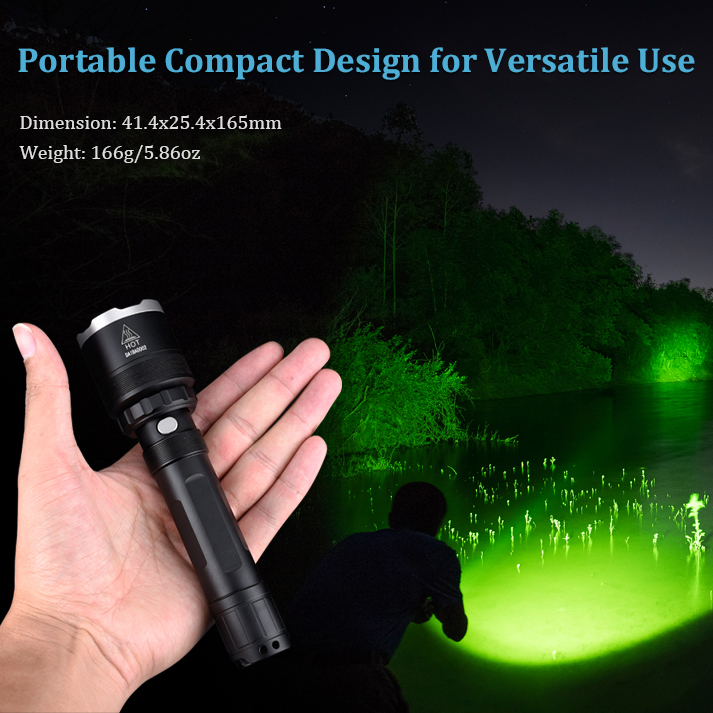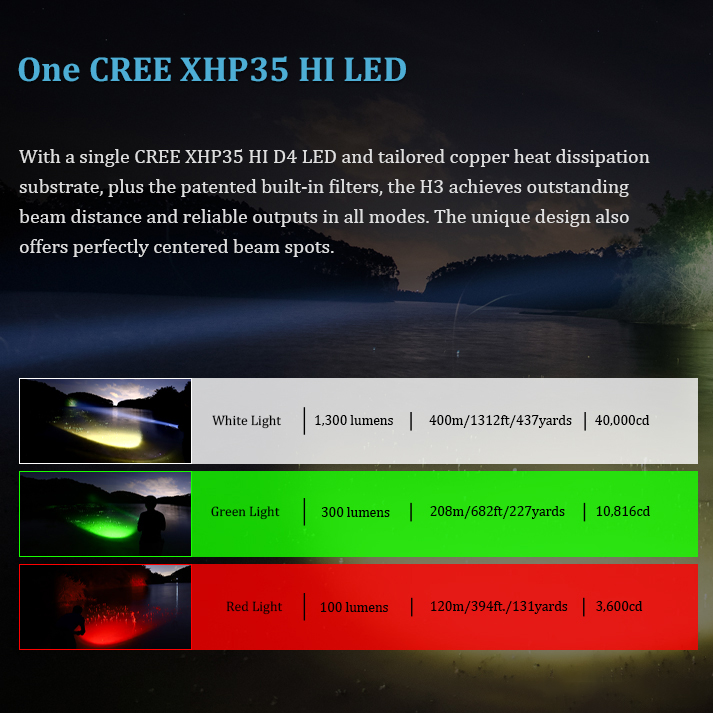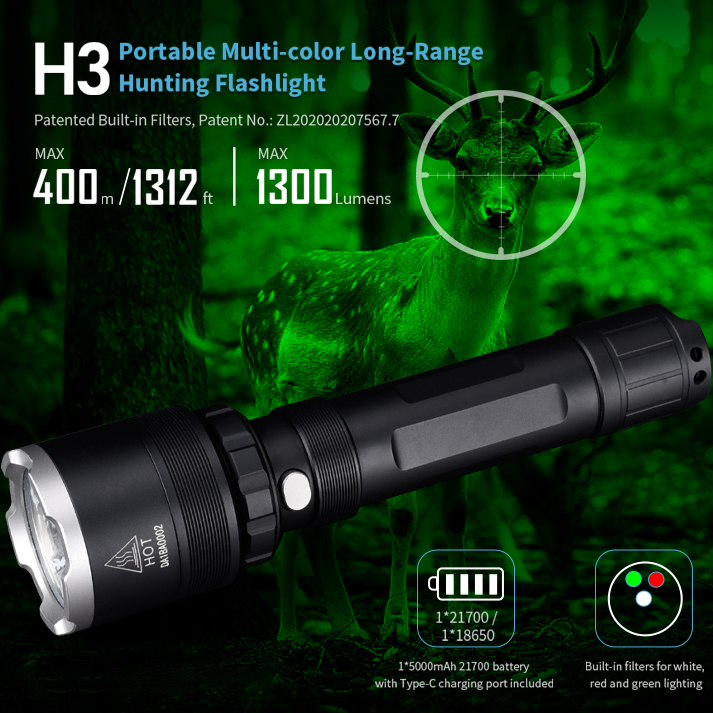
Introduction
The use of flashlights is essential for hunters, providing them with the necessary illumination during their expeditions. When it comes to hunting, choosing the right flashlight can make a significant difference in your overall experience and success. Two popular options that hunters often consider are green light flashlights and white light flashlights. Each type has its own unique advantages and benefits, making it important to understand the differences between them. In this blog post, we will compare green light flashlights versus white light flashlights specifically for hunting purposes.
Green light flashlights have gained popularity among hunters due to their ability to enhance night vision while minimizing disruption to wildlife. The human eye is less sensitive to green light compared to other colors, allowing hunters to navigate through the darkness without disturbing animals or attracting unwanted attention. This makes green light flashlights an ideal choice for those who want to remain undetected in their hunting environment.
On the other hand, white light flashlights offer a broader spectrum of visibility, providing hunters with a clearer view of their surroundings. White light is more versatile and can be used in various situations beyond just hunting. It can illuminate larger areas effectively and may be preferred by those who need a brighter source of light for tracking or scanning large distances.
When deciding between green and white light flashlights for hunting, there are several factors that should be taken into consideration. One important factor is the type of game being hunted. Some animals may be more sensitive to certain colors of light than others, so understanding the specific characteristics of your target species can help inform your decision.
Furthermore, it's crucial to consider the terrain and environment in which you will be hunting. Green light may blend better with foliage and vegetation, making it less noticeable compared to white light in certain settings. Conversely, if you are hunting in an open field or wide-open spaces, white light may provide better overall visibility.
Benefits of Green Light Flashlights
Green light flashlights offer several benefits that make them an excellent choice for hunting in low light conditions. One of the main advantages of using green light is enhanced visibility. Green light has a longer wavelength compared to white light, which means it can penetrate through fog, mist, and other atmospheric conditions more effectively. This enhanced visibility allows hunters to see their surroundings clearly and spot potential targets with greater ease.
Another benefit of green light flashlights is their ability to reduce the impact on night vision. When using white light flashlights, the sudden burst of bright light can temporarily blind hunters and disrupt their natural night vision. In contrast, green light is less harsh on the eyes and helps preserve night vision. This is particularly important during nighttime hunts when maintaining a clear line of sight is crucial.
Furthermore, green light flashlights are less likely to spook animals. Animals are more sensitive to certain colors of light, and studies have shown that they are less reactive to green light compared to white or red light. The subdued nature of green light makes it less alarming to wildlife, allowing hunters to observe animals without causing unnecessary disturbance.
In addition to these benefits, green light flashlights also have a longer battery life compared to white light flashlights. This can be especially advantageous during extended hunting trips when access to power sources may be limited.
Advantages of White Light Flashlights
White light flashlights offer several advantages that make them a popular choice among hunters. One of the main advantages is their greater overall brightness compared to green light flashlights. The white light emitted by these flashlights is typically brighter and more intense, allowing hunters to see objects and their surroundings with greater clarity. This increased brightness can be especially beneficial in low-light conditions or when trying to spot animals from a distance.
Another advantage of white light flashlights is their ability to provide better color rendering. Unlike green light, which can distort colors and make it difficult to distinguish between different objects, white light provides a more accurate representation of colors. This can be particularly useful when tracking blood trails, as it allows hunters to identify and follow the trail more effectively.
In addition to these benefits, white light flashlights are also versatile in their use. They can be used for various purposes other than hunting, such as camping or emergency situations. Their widespread availability and affordability make them easily accessible for most outdoor enthusiasts.
However, there are some factors to consider when choosing between green and white light flashlights for hunting. While white light may offer greater brightness and color rendering, it can also have drawbacks. The intense brightness of white light can sometimes startle or scare away animals, making it harder to approach them unnoticed. Green light, on the other hand, has been found to have less impact on wildlife and may be less likely to spook animals.
Ultimately, the choice between green and white light flashlights will depend on personal preferences and specific hunting conditions. It's important for hunters to consider factors such as target species, terrain, and lighting conditions before making a decision. By weighing the advantages and disadvantages of each type of flashlight, hunters can choose the option that best suits their needs and maximizes their chances of success in the field.
Factors to Consider

When choosing between green light flashlights and white light flashlights for hunting, there are several factors to consider. The hunting environment and terrain play a crucial role in determining which type of flashlight is most suitable. Green light flashlights tend to be more effective in heavily wooded areas or dense vegetation where visibility may be limited. The green light has a longer wavelength, making it easier for the human eye to perceive contrasts and shapes in low-light conditions.
On the other hand, white light flashlights offer their own advantages in certain hunting situations. They provide a brighter and more natural illumination, allowing hunters to see colors accurately and spot details with greater clarity. This can be particularly beneficial when tracking wounded game or searching for specific landmarks or trail markers.
Personal preference also plays a significant role in the decision-making process. Some hunters may have a personal preference for one color over the other based on past experiences or individual preferences. It's important to consider what works best for you and your hunting style.
Battery life and durability are additional factors that should not be overlooked. Green light flashlights often consume less power compared to white light flashlights, resulting in longer battery life. This can be advantageous during extended hunting trips or when access to charging facilities is limited. Additionally, considering the ruggedness and durability of the flashlight is essential, as hunting often involves rough terrains and adverse weather conditions.
Impact of Different Light Colors on Hunting Success

The choice of light color can have a significant impact on hunting success. Different animals have different sensitivities to light, and understanding these differences can give hunters an advantage in the field. One popular option for hunting is using green light flashlights. Green light has been found to be less disruptive to many nocturnal animals compared to white light. This is because the eyes of many animals are less sensitive to green light, allowing hunters to observe their surroundings without alarming potential prey.
Using green light flashlights also has its advantages when it comes to tracking wounded game. The low sensitivity of animals' eyes to green light means that it is less likely to startle or spook them during the tracking process. This allows hunters to more effectively follow blood trails or footprints without causing additional stress or fear in the animal. Additionally, green light tends to scatter less in dense foliage, making it easier for hunters to navigate through thick vegetation while maintaining visibility.
On the other hand, white light flashlights have their own set of advantages for hunting. White light provides a broader spectrum of colors, allowing for better color recognition and depth perception. This can be particularly useful when identifying specific targets or distinguishing between similar-looking animals in low-light conditions. White light also tends to provide a brighter illumination compared to green light, which can be beneficial when scanning large areas or spotting distant objects.
When choosing between green and white light flashlights for hunting, there are several factors that need to be considered. The specific type of game being hunted, the environment in which the hunt takes place, and personal preferences all play a role in determining which color of flashlight is most suitable. It may be necessary for hunters to experiment with both options and assess their effectiveness based on individual circumstances.
Tips for Using Green and White Light Flashlights Effectively
When it comes to using green and white light flashlights effectively while hunting, there are several key tips to keep in mind. First and foremost, it is important to properly adjust the intensity of the light. Too much brightness can startle or scare away animals, while too little may not provide enough visibility. Finding the right balance is crucial.
In addition to adjusting the intensity, it is also important to avoid excessive movement when using a flashlight. Animals have keen senses and can easily detect even subtle movements. To minimize the chances of startling them, hunters should try to keep their movements slow and controlled.
Another tip for using green and white light flashlights effectively is to use the light strategically. This means being mindful of where the light is directed and how it illuminates the surroundings. For example, shining the light directly at an animal's eyes can temporarily blind them and potentially cause them to flee. Instead, hunters should aim for indirect lighting that provides enough visibility without causing unnecessary disturbance.
Furthermore, hunters should consider using different colored lights for different purposes. Green light has been found to be less disruptive to wildlife compared to white light. It tends to blend in better with natural surroundings and does not attract insects as much as white light does. On the other hand, white light offers better color rendering and may be more suitable for tasks requiring accurate identification of objects or terrain features.
By following these tips, hunters can maximize their effectiveness when using green and white light flashlights during hunting expeditions. Remembering to adjust the intensity appropriately, minimize movement, use strategic lighting techniques, and consider different colored lights based on specific needs will greatly enhance one's hunting experience.
Conclusion
In conclusion, when it comes to choosing between green light flashlights and white light flashlights for hunting, there are several factors to consider. Both types of flashlights have their own benefits and advantages. Green light flashlights are known for their ability to enhance night vision and reduce eye strain. They are less likely to startle game animals and can be effective in illuminating targets without alerting them. On the other hand, white light flashlights provide a brighter and more natural illumination that can be useful in certain hunting situations. They may offer better visibility over longer distances and can help with tracking wounded game.
When deciding which type of flashlight to use for hunting, it is important to consider the specific needs of your hunting environment and style. Factors such as terrain, weather conditions, and target species should all be taken into account. Additionally, personal preferences and comfort levels with different types of lighting should also be considered.
The impact of different light colors on hunting success is a topic that continues to be debated among hunters. Some believe that green light is less likely to spook game animals, while others argue that white light provides better visibility in certain situations. Ultimately, the choice between green and white light flashlights will depend on individual preferences and the specific hunting scenario.
To effectively use both green and white light flashlights while hunting, it is important to practice proper flashlight techniques. This includes using the appropriate brightness level for the situation, avoiding shining the flashlight directly at game animals, and being mindful of how your movements may affect your visibility.
In conclusion, whether you choose a green light flashlight or a white light flashlight for hunting, both options have their advantages. It is important to carefully consider your specific needs and preferences when making a decision. By selecting the right flashlight for your hunting adventures, you can enhance your visibility in low-light conditions and increase your chances of success in the field.
See Also
Effective Tips for Utilizing the CYANSKY HS6R Headlamp: Red Light for Camping, Hiking, and Hunting
Comparing Zoomable Flashlight and Reflector Cap: Which is Suitable for You?
Optimal Light Color for Repelling Bugs: A Guide for Homeowners
Selecting the Perfect Flashlight Color: An In-Depth Guide for Outdoor Enthusiasts
Comparing Police Flashlight and Regular Flashlight: Which One is Superior?